Estimated reading time: 6 minutes
With spring underway, weeds will start to grow in earnest under your fruit trees.
This means that unless you’ve got a highly manicured garden, there’s a good chance that the plants that grow under your fruit trees are likely to start looking out of control pretty soon.
Related Articles
Fruit tree leaves: bonus or problem?
Should you let the leaves from your fruit tree stay on the ground in autumn, or are you just asking for trouble? We’ll help you decide.
Should you spray your fruit trees in autumn?
Spraying fruit trees should always be kept to a minimum to protect soil health, but sometimes a spray in autumn is the right thing to do.
How to plant a green manure crop
Prepare the soil before planting fruit trees with an autumn green manure crop, and give your fruit trees the best possible chance to thrive.
We often refer to weeds as “understorey plants” and consider management of them as one of the key parts of fruit tree care.
If you look really hard at the photo below you’ll see that in amongst the riot of greenery, there are some almond trees. Hmmm, this is taking understorey to the next level – it’s almost become the overstorey!
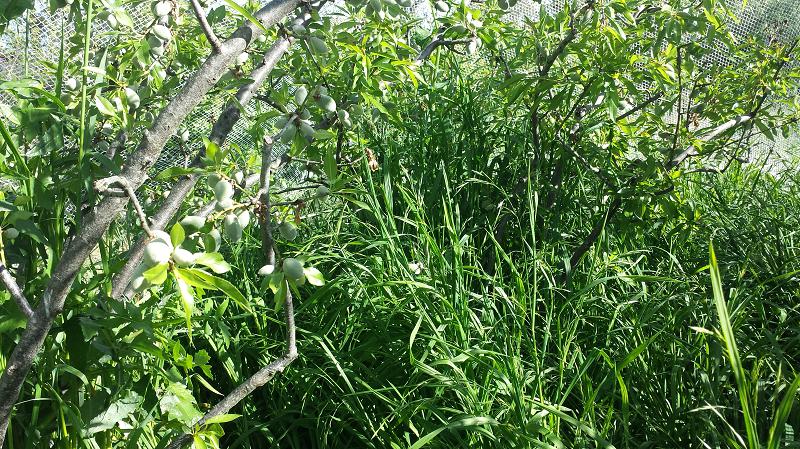
But aren’t weeds under fruit trees (or anywhere) bad?
If you were to take your cue from garden supply shops, you would think that weeds are the devil. They’d like you to use one of the many chemicals (herbicides) they sell, to kill them.
If you have a look at the ingredients on these colourful bottles, you’ll find that many of them contain a chemical called glyphosate. In our opinion, this is much more devilish than the weeds. Read what we’ve previously written about this pervasive chemical here.
If you don’t fancy chemicals, you may have spent many hours of your life pulling up weeds.
This is at best a temporary solution and takes lots of time and energy. Maybe you’ve tried organic weedkillers instead – also probably with less than satisfying results.
The organic approach to weed control
We’d like to propose an alternative mindset…that weeds have their place in your garden.
One of the major ways that organic gardens and farms differ from those that use chemicals like herbicides is that we appreciate the many benefits that weeds can provide.
Unfortunately, in many gardens, it’s still routine to use herbicides to kill every weed in sight. This is a terrible pity, as it can do quite a bit of damage to the ecosystem (not to mention the now well-known risks to human health).
On farms, this is because monoculture systems that rely on artificial inputs like fertilisers see growing anything other than the target crop as a disadvantage.
In gardens, it’s often simply a case of misinformation or the desire for a “tidy” garden.
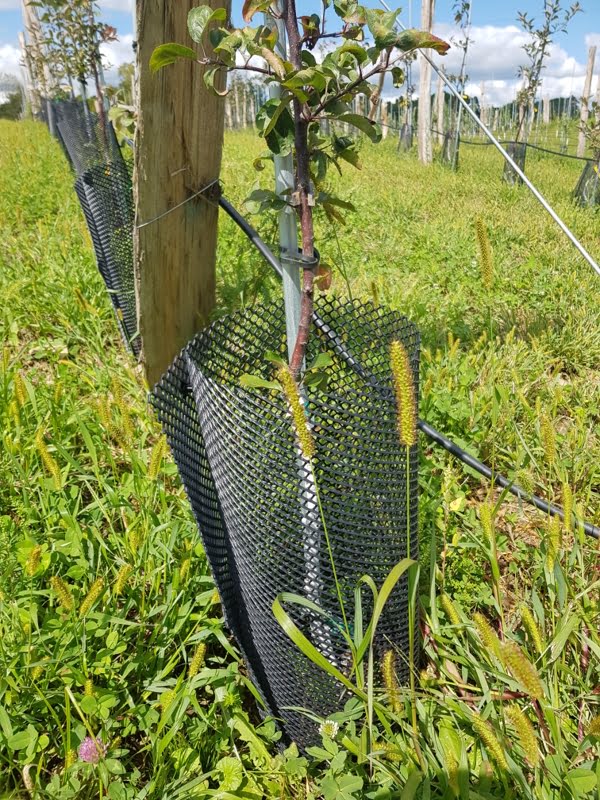
Why we never recommend herbicides
We reckon killing weeds completely misses the point of creating a complex and diverse habitat.
It also ignores the many environmental benefits of weeds. The primary one is the fact that their roots talk to each other and even swap genetic material, as explained by Dr. Christine Jones in this must-see masterclass.
In addition to that, they shade the ground. They provide crucial habitat and food for the soil microbes that are so important for fertility for our trees. They also take carbon out of the air and pump it into the soil.
If you have animals at your place, weeds can also be a wonderful source of feed. In exchange, the animals will fertilise your soil, eat pests, and possibly even provide you with other benefits like eggs or meat (if you’re not vegetarian).
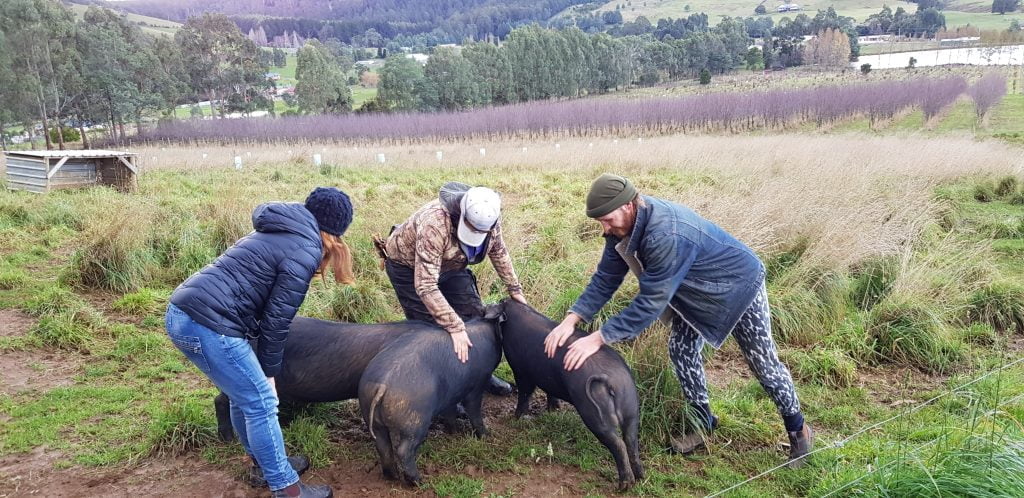
The downside to weeds
However, there can be a downside to having weeds under your fruit trees.
- They may provide habitat for insect pests.
- Long grass and weeds make handy ‘ladders’ into the trees for crawling insects like earwigs and garden weevils.
- They can make it harder to work around your tree.
- And if you’re unfortunate enough to possess the “neat gene” they provide a constant source of friction.
Like most things in gardening and farming, deciding how to manage your weeds and understorey plants is a matter of weighing up the pros and cons.
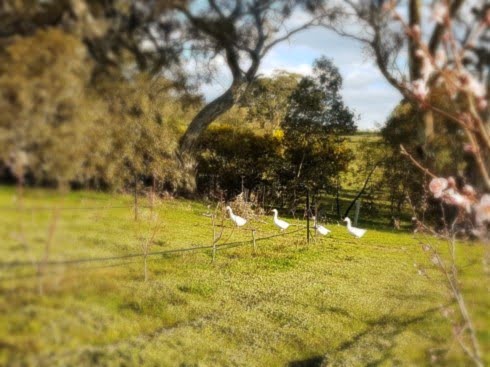
We reckon in most circumstances the pros of weeds by far outweigh the cons. To get the maximum benefit from them we recommend keeping them short and not letting them go to seed.
This keeps the plant active in terms of pumping carbon into the soil. They use less water, and it provides a much nicer environment to work around the trees if the weeds are short.
Since being exposed to the revolutionary ideas of Dr. Jones, we’re moving much more towards establishing permanent garden beds of flowers, herbs, and vegetables under our trees to out-compete the “weeds”. We’re also working closely with our Grow Great Fruit members to do the same.
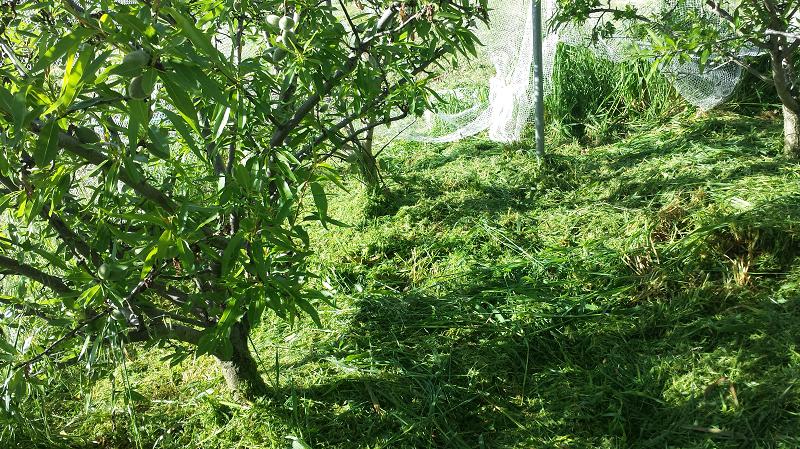
Top three tips for managing weeds under your fruit trees…
Here are a few ways we suggest you can manage the plants under your fruit trees in spring:
- Keep them short: The best and most natural way to do this is with animals. If you have access to pigs, geese, or chickens they can do the job for you at no cost. Otherwise, mow the weeds with a mower or hand scythe before they get too long. This helps to keep them in the growing phase.
- Grow something useful that you want. We aim for a mix of flowers, vegetables, grasses (for maximum organic matter), legumes (for nitrogen fixation from the atmosphere), and culinary herbs (for the different nutrients they ‘mine’ from the soil). You may already have useful plants growing among the weeds that naturally occur. If you’re not sure whether you do, it’s a great idea to learn how to recognise them and understand their many uses. The Guide to Edible Flowers is a great resource to help you decide what to plant.
- Don’t give pests an advantage. Don’t let the plants under your fruit trees become a ladder for pests to get into your tree. Long grass left un-managed can also become a habitat for pests like grasshoppers. #1 (above) is a good short-term strategy, with #2 being the ideal long-term strategy. In the meantime mulching around your fruit trees can help to keep the weeds down for a bit longer in between mows.
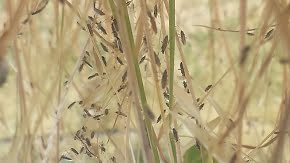
Related Articles
Fruit tree leaves: bonus or problem?
Should you let the leaves from your fruit tree stay on the ground in autumn, or are you just asking for trouble? We’ll help you decide.
Should you spray your fruit trees in autumn?
Spraying fruit trees should always be kept to a minimum to protect soil health, but sometimes a spray in autumn is the right thing to do.
How to plant a green manure crop
Prepare the soil before planting fruit trees with an autumn green manure crop, and give your fruit trees the best possible chance to thrive.

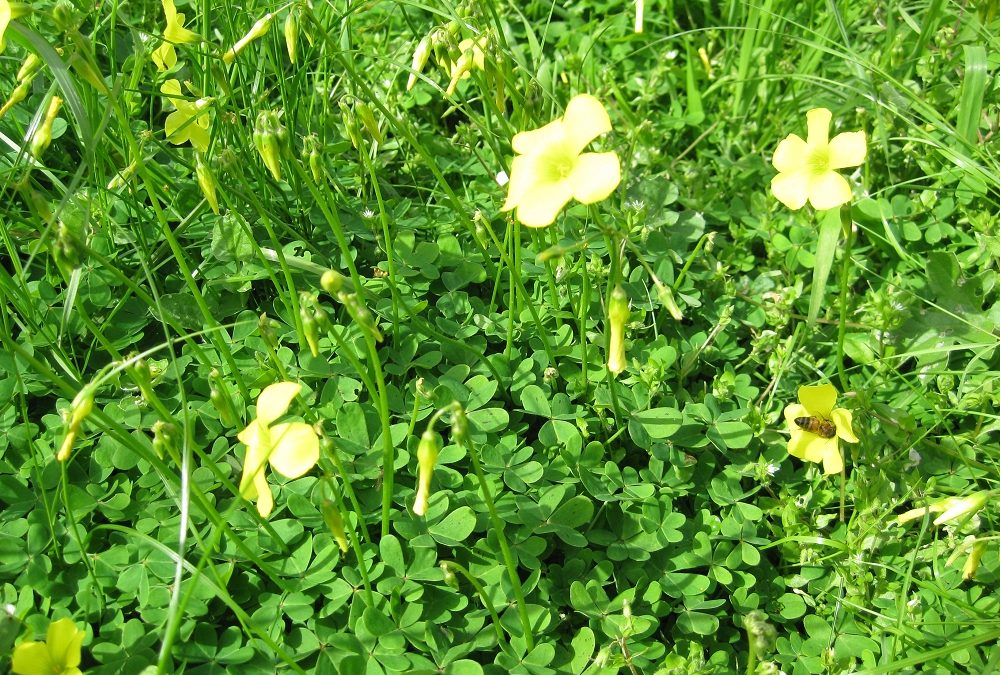
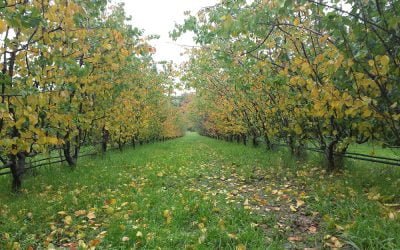
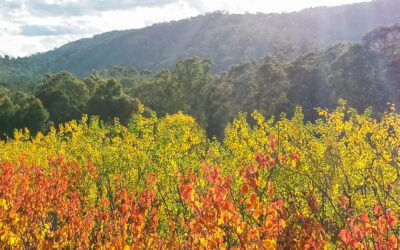
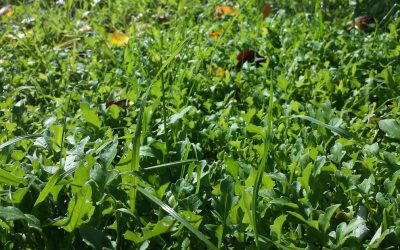


What do you consider ‘young’ trees?
When should I consider transitioning to a ‘living’ understorey instead of using mulch?
Hi Janice – good question, we normally think of young trees as the first 2-3 years, roughly the same time as we’re doing the “establishment” pruning when we’re creating the right shape in our trees, after which we let them settle down and start fruiting, but be guided by the tree as well. If it’s not looking really vigorous and growing strongly you might baby it along until it’s looking better established.
Are those tree guards black fine wire? What is it called?
This is a bit left of centre as it relates to raspberries…but they are fruit after all! My autumn raspberries were a disaster this year as I was scared to cut back the weeds lest I kill emerging raspberries (having cut the canes right back last season). Raspberries grew, but so did the weeds. In the end our raspberries canes looked brownish and did not produce a single berry. Next season I am going to mulch extensively (as I will for my fruit trees) but I am wondering whether you have any thoughts?
Hi Grant, the weeds may have had an impact on whether your raspberries fruited this year, but shouldn’t have made the difference between whether they fruited or not, unless there was another issue going on, like lack of water. Raspberries are also terribly prone to Phytophthora which causes the canes to go brown and die back, so that’s a possibility as well. Raspberries are also quite tough (if they’re not diseased), so cutting the canes back again and mulching next year should help. Also, give them a good feed with something like high-quality compost over winter. Good luck!
Some raspberry canes only fruit on 2nd year wood. So might not get any fruit if you keep cutting them down to ground every year:(
You’re right Alison, definitely important to work out the variety you’re working with. If in doubt, best to tie up any first year canes and then observe what happens in the next season. Meg – Grow Great Fruit team.